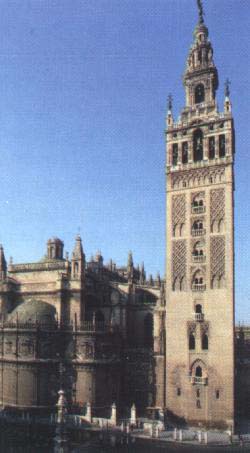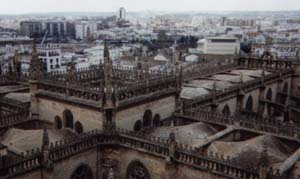

A long tiring flight ended on a runway seven miles from the heart of the Barrio Santa Cruz, the old section of the largest city in the Andalucian part of Spain. A rented car awaiting we set forth on a journey that would take us through the Giralda with its shining spires, to the beauty of the great Cathedral and to the Alcazar with its rambling Alcazar gardens.
Seville is a stunning slice of Spanish culture and scenery but finding our first hotel was a journey in itself. Confident after quickly winding our way from the airport to the Santa Cruz area, we did not think it a problem to find our hotel nicely marked on a map provided by the internet. But within the corridors of an area that had no recognizable contrivance, it was a challenge. The beautifully designed pebbled roadways were never but a few meters long and were never straight enough to view a streets other end. Connecting corners to other roads were often sharp and sometimes did not afford enough width for an automobile. Often, while attempting to find our way we found ourselves on a forbidden path or going the wrong way. Because direction had no meaning we would often pass the same police officer that had previously warned us of our misdeeds. After two hours of searching and still not in jail, we found the "Murillo" hotel, a very old converted mansion that I chose from recommendations made by inquiries off the Internet. With many Spanish citizens offering to help us despite our struggle in language communication, some of them police officers, we had our first taste of Spanish hospitality and the kindness and understanding of the Spanish people.
The Santa Cruz Quarter, a wonderment to behold, is a section of Seville (Sevilla) that tries the imagination. One sees on either side of its cobblestoned, curved and confined roadways, row upon row of structures with flowered balconies, richly decorated facades and hidden patios. Where once individual homes would stand, now multiple dwellings, retail shops, restaurants and bars abound. The once massive mansion on Rueda Street with its balconies spread across its magnificent baroque style front is now the Murillo Hotel where we stayed our first two nights in this historic city. Named after one of the most important and famous painters of Seville, the Murillo with its interior of antique furnishings and carved wood is a clean, comfortable and very affordable two star hotel.
 Never really getting our navigational directions conjoined,
we did, however, manage to find our way from our hotel to the
Santa Cruz edges and back again as I am sure did the many other
tourists we saw meandering up and down these pathways with
useless maps in hand. Among the many restaurants and Tapa bars
within these walls we chose the Giralda to experience our first
authentic Andalucian meal. A nicely decorated little cove
containing about eight tables surrounding a fountain which
provided both a pleasant visual and sweet musical effect. The
solitary operator served us Sangria, salad, breads and Paella.
Never really getting our navigational directions conjoined,
we did, however, manage to find our way from our hotel to the
Santa Cruz edges and back again as I am sure did the many other
tourists we saw meandering up and down these pathways with
useless maps in hand. Among the many restaurants and Tapa bars
within these walls we chose the Giralda to experience our first
authentic Andalucian meal. A nicely decorated little cove
containing about eight tables surrounding a fountain which
provided both a pleasant visual and sweet musical effect. The
solitary operator served us Sangria, salad, breads and Paella.
Entering into another world, another perspective and another time we experienced not only the home of an ancient civilization, but also a lifestyle deeply rooted in the earth suffused with passion and improvisation, the historical cradle of flamenco - and no one should visit Seville without encountering the Flamenco show. Anxious to begin our Spanish experience and despite our long and tiring flight, we visited the nearby, LOS GALLOS Tabloa Flamenco. One of the characteristics of Los Gallos is the capacity of maintaining the authenticity of the Flamenco show, with pure CANTE Y BAILE FLAMENCO (flamenco singing and dancing). A delightful evening you should be determined not to miss.
Suffering from caffeine withdrawal, our next mornings challenge was to find coffee and something to eat. A tapa bar just outside the Santa Cruz border looked acceptable and provided us with great Spanish coffee, orange juice and breads, just adequate enough to sustain us through our days planned tours of the Cathedral and the Alcazar.
 The Cathedral in company with its Giralda tower would be our
first visit of the day. The morning serene and lovely with a sun
still without sufficient power to destroy the freshness of the
night, we would climb, in paltry light, the approximately 36
cobbled and stepless inclines along the inside walls of the
Giralda tower to the apex where beneath the towers renaissance
bells we could take a birds eye view, in all directions, of the
City below. At length we arrived at the summit, took a breath for
a moment, and then cast a general eye over the splendid panorama
of the city below us. I can only imagine that proud monarchs
must have ascended this same path to watch the approach of
Christian armies or to gaze upon the battles in the fields
below.
The Cathedral in company with its Giralda tower would be our
first visit of the day. The morning serene and lovely with a sun
still without sufficient power to destroy the freshness of the
night, we would climb, in paltry light, the approximately 36
cobbled and stepless inclines along the inside walls of the
Giralda tower to the apex where beneath the towers renaissance
bells we could take a birds eye view, in all directions, of the
City below. At length we arrived at the summit, took a breath for
a moment, and then cast a general eye over the splendid panorama
of the city below us. I can only imagine that proud monarchs
must have ascended this same path to watch the approach of
Christian armies or to gaze upon the battles in the fields
below.
 To one side - the city of Seville today. Its industry and
streets a common sight of an urban city known. But then depart
from this side and turn an eye to the other. Here behold the
city of old, the Santa Cruz. From here one might envision men
riding their mighty steeds as they travel to and from their
homes on roads sufficient to meet another whilst still others
walk its cobbled lanes. Today the occasional car that dares
select this path is often compelled to retreat for lack of
breadth - and too - let the passer-by beware.
To one side - the city of Seville today. Its industry and
streets a common sight of an urban city known. But then depart
from this side and turn an eye to the other. Here behold the
city of old, the Santa Cruz. From here one might envision men
riding their mighty steeds as they travel to and from their
homes on roads sufficient to meet another whilst still others
walk its cobbled lanes. Today the occasional car that dares
select this path is often compelled to retreat for lack of
breadth - and too - let the passer-by beware.
Seville's Cathedral is the world's second largest church after the Basilica in the Vatican, Rome. But in terms of gold and silver, it is the wealthiest on earth. The Cathedral consists of a large open area, contains 5 naves and 25 chapels and a vast, gleaming altar - said to be the largest in the world and the work of one craftsman. Gilded with absurd amounts of gold, this extraordinary woodcarving depicts the life of Christ. The separate Royal Chapel contains many of the works by Murillo, Zurbarán, Valdés Leal and Goya among others.
From the Cathedral we elect a horse and buggy ride which would encompass the prevailing old town area. Dozens of these vehicles fill the courtyard in front of the Cathedral to which their drivers solicit riders in hopes of making a tolerable daily stipend.
At completion of this excursion with its much appreciated rest to legs and feet, we visited the Alcazar. This fortress was once but a palace, albeit a huge one. It is a bewildering complex of palace apartments, patios and salons that have been renovated, rebuilt and added to by a succession of Spanish kings. In its interior, the outstanding palace grounds, gardens and service quarters are spread throughout areas enclosed by walls on the premises just outside the Santa Cruz where we were staying. Rather than one homogenous architecture, it is a rather austere and lifeless place. Our guide informed us that these structures were created by Muslim artistic elements intertwined with others from the Gothic, Renaissance and Baroque periods. One could see the influences of Christianity when life forms were introduced as artistic décor among the interior surfaces.
Following our tour of the Alcazar we sought to experience more of Spain's edible delicacies. The cuisine in Seville includes some of its best-known dishes such as gazpacho, bull's tail, fish fried in olive oil, chickpea stew and cured codfish. Okay - so we chose McDonalds. It's our habit to visit McDonalds once (and only once) in every country we visit. That evening however, we experienced one of Spain's contributions to gastronomy - the tapa. These little portions of regional specialty are served in restaurants and bars throughout Spain. A tapa or two along with a beer (Cerveza), coffee or Sangria is all one needs to satisfy the pallet.
We were to encounter many of these little eating and drinking establishments along our journey. Step out of the Andalucian sunshine. Just follow the pedestrians through a little doorway, into the cool interior of a typical tapa bar. Multi-colored tiles line the walls while clay tiled floors shine with wear from years of footsteps. Wines are stacked behind the bar while prominent is the coffee maker which exquisitely brews that flavorful bean one cup at a time. Also seen is the juicer, that marvelous contraption that squeezes the succulent contents of each dripping orange introduced to it. From wooden beams hang whole hams and links of sausages, ropes of garlic and peppers.
What really draws you in are the aromas wafting from beneath the glass covered counters, as plate after plate of tapa dishes are placed on the bar. Tapa hopping seems to be a part of the Andalucian way of life. With our friends we would stop in at several bars to sample the tapa specialties of each establishment.
Certainly we could have spent many more days in Seville. We experienced only that which was near by foot during our two-day stay. We did not wish to loose the parking spot we were fortunate to find in an area where space was at such a premium that cars were found on sidewalks, aside other cars so as to prevent them from moving, in driveway entrances and, sometimes, just in the middle of a street. If a road was wide enough to make two lanes one always became a parking area. "No parking" symbols and signs were meaningless.
Early the third morning we packed the car, found a little cafe to have our much needed morning orange juice and coffee, and then set out to find Granada.
 Next Page
Next Page


